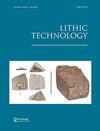Broad-Spectrum Foraging, Trade, and Lithic Technology: A First Approach to the Slab Stone Tools from Prehispanic Sierras of Córdoba, Argentina
IF 1.2
3区 社会学
Q2 ANTHROPOLOGY
引用次数: 0
Abstract
ABSTRACTThe article presents the study of the slab stone tools collected at the San Roque locality (Sierras of Córdoba, Argentina), a poorly known tool type that merits more detailed studies. . The assemblage was also analyzed from a technological-functional point of view, but the source of raw materials was also investigated to infer the range of past mobility and/or the size of trade networks. The major cost of tools was represented by the systematic acquisition of the raw material from the quarries located 25–200 km rather than by manufacturing. Technological attributes and use-wear on active edges suggest that they were broad-functional tools linked to the need for a broad-spectrum adaptative strategy that required diverse tools for processing a wide variety of foodstuff and their by-products. The landfall of crop plant cultivation ca. 1200 years BP, probably increased the need for this tool type, reinforcing pre-existent trade networks for raw material acquisition. .KEYWORDS: Lithic technologyHolocenebroad-spectrum foraging basetool stonesquarries AcknowledgmentOur acknowledgment also extends to Museo Arqueológico Numba Charava, Reserva y Laboratorio Achala Sacate, Agencia Córdoba Cultura, J. Sfragulla, G. Guraieb, J. Montegú, M. Leipus, D. Rivero, J. Belardi, R. Barberena, L. Tissera, M. Gritti, I. Traktman and M. Traktman, who provided professional advice, equipment and replied to our numerous requests to improve the original text.Disclosure StatementNo potential conflict of interest was reported by the author(s).Additional informationFundingThis work was supported by Secretaría de Ciencia y Tecnología de la Universidad Nacional de Córdoba [Proyecto CONSOLIDAR 33620190100011CB], the Consejo Nacional de Investigaciones Científicas y Técnicas [PIP 11220200100770CO] and of the Agencia Nacional de Promoción Científica y Tecnológica [grant number 2016-201-0677].Notes on contributorsGisela SarioGisela Sario is an Adjunt Researcher of the Consejo Nacional de Investigaciones Científicas y Técnicas (CONICET) and Professor of the Facultad de Filosofía y Humanidades (Universidad Nacional de Córdoba, Argentina). She got the degree of Ph.D. in Archaeology from the Universidad Nacional de Córdoba (Argentina) in 2011. She is focusing his research on the Late Holocene foragers and horticuralist from Southern Punilla Valley. There, she has been leading research grant-funded projects since 2018, where she carried out archaeological surveys, stratigraphic excavations, and the analysis of multiple evidence, including lithic, pottery remains, and architecture. Moreover, she also made significant contributions to the archaeological knowledge of early peopling of the Americas in Sierras de San Luis, a neighboring mountain range from Sierras of Córdoba. She published the results of her research in high-impact peer-reviewed journals from Argentina, Chile, Spain, Italy, the USA, the UK, and Germany.Marcos SalvatoreMarcos Salvatore is Geologist of the Comisión Nacional de Energía Atómica (CNEA, Regional Centro). He is focusing his research on the prospecting-exploration of rocks and minerals in areas of La Rioja, Argentina. These tasks are accompanied with the support of petrological-mineralogical determinations, through the preparation and observation of thin sections of rock and in particular cases X-ray diffractions and EDS. He is finishing his master’s degree in Environmental Engineering.Florencia CostantinoFlorencia Costantino is a PhD. Student in Anthropology from the Universidad Nacional de Córdoba (Córdoba, Argentina). She is finishing his Ph.D. thesis focused on the lithic technology of semi-sedentary people from Sierras of Córdoba (Argentina), under the supervision of a Ph.D. Gisela Sario. She participated in diverse meetings, articles, research projects, and numerous fieldwork in Argentina.Sebastián PastorSebastián Pastor is an Independient Researcher of the Consejo Nacional de Investigaciones Científicas y Técnicas (CONICET) and of the Instituto Regional de Estudios Socio-Culturales (IRES, Catamarca). He got the degree of Ph.D. in Anthropology from the Universidad Nacional de La Plata (La Plata, Argentina) in 2007. He finished his postdoctoral fellowship in the Departamento de Prehistoria y Arqueología of the Universidad de Sevilla and the Instituto de Ciencias del Patrimonio of Santiago de Compostela (Spain) in 2012. He is primarily interested in the cultural evolution of mixed economies from central Argentina, including the Sierras of Córdoba and the Llanos of La Rioja, where he led, co-leaded, and participated in different research projects since 1995. He also made significant contributions to the archaeological knowledge of early peopling of the Americas, rock art, and the early post-contact native people’s lifeways (XVI-XVII centuries AD). S. Pastor published about archaeology in books and peer-reviewed journals from Spain, Colombia, the United States, Slovenia, Colombia, Chile, and Argentina. Moreover, he participated in numerous scientific meetings in Argentina and Europe.Matías E. MedinaMatías E. Medina is an archaeologist primarily interested in multi-resource-based prehispanic economies and how they impacted on ancient environments. He is an Independent Researcher of the Consejo Nacional de Investigaciones Científicas y Técnicas (CONICET) and of the División Arqueología, Facultad de Ciencias Naturales y Museo (Universidad Nacional de La Plata, Argentina). He got the degree of Ph.D. in Archaeology from the University of Buenos Aires (Argentina) in 2008. He is focusing his research on the Late Prehispanic Period of the Sierras of Córdoba (∼1220–330 cal BP, Argentina). There, he has leaded, co-leaded and participated in different research grant-funded projects about this topic since 2000, where he carried out archaeological surveys, stratigraphic excavations and the analysis of multiple evidences, including architecture, pollen, faunal, plant, pottery and lithic remains. Moreover, he also made significant contributions to the paleobiology of the mountain biota, applying archaeological data to improve wildlife management decisions. He published the results of his multidisciplinary research in books and high-impact peer reviewed journals from Spain, USA, UK, Germany, Australia, Slovenia and France.广谱觅食、贸易和石器技术:对阿根廷Córdoba前西班牙时期塞拉斯的石板石器的初步研究
摘要本文介绍了在阿根廷圣罗克地区(Córdoba的塞拉斯山脉)收集的石板石器的研究,这是一种鲜为人知的工具类型,值得更详细的研究。还从技术功能的角度分析了这些组合,但也调查了原材料的来源,以推断过去流动性的范围和/或贸易网络的规模。工具的主要成本是系统地从25-200公里的采石场获取原材料,而不是制造。活动边缘的技术属性和使用磨损表明,它们是功能广泛的工具,与广谱适应策略的需求有关,这种策略需要多种工具来加工各种各样的食品及其副产品。大约1200年前作物种植的登陆,可能增加了对这种工具类型的需求,加强了先前存在的原材料获取贸易网络。我们还要感谢博物馆Arqueológico Numba Charava, Achala Sacate, Córdoba文化机构,J. Sfragulla, G. Guraieb, J. Montegú, M. Leipus, D. Rivero, J. Belardi, R. Barberena, L. Tissera, M. Gritti, I. Traktman和M. Traktman,他们提供了专业的建议和设备,并回复了我们对原始文本的大量改进请求。披露声明作者未报告潜在的利益冲突。本研究得到了Secretaría de Ciencia y Tecnología de la nacuniversidad de Nacional de Córdoba [Proyecto CONSOLIDAR 33620190100011CB]、国家调查委员会Científicas y tacimnicas [PIP 11220200100770CO]和国家机构Promoción Científica y Tecnológica[资助号2016-201-0677]的支持。关于捐助者的说明isela Sario isela Sario是Científicas和<s:1> <s:1> <s:1> <s:1> <s:1> <s:1> <s:1>国民健康健康调查委员会(CONICET)的助理研究员和Filosofía和人类学院(Córdoba,阿根廷国立大学)的教授。2011年获阿根廷国立大学Córdoba考古学博士学位。她的研究重点是来自南普尼拉山谷的全新世晚期觅食者和园艺家。自2018年以来,她一直在那里领导研究资助项目,在那里她进行了考古调查、地层挖掘,并分析了多种证据,包括石器、陶器遗骸和建筑。此外,她还对美洲早期人类的考古知识做出了重大贡献,sierra de San Luis山脉与Córdoba的sierra山脉相邻。她的研究成果发表在阿根廷、智利、西班牙、意大利、美国、英国和德国的高影响力同行评议期刊上。马科斯·萨尔瓦托是Comisión国家Energía Atómica (CNEA,区域中心)的地质学家。他的研究重点是在阿根廷拉里奥哈地区勘探岩石和矿物。这些任务伴随着岩石矿物学测定的支持,通过制备和观察岩石薄片,特别是x射线衍射和EDS。他正在攻读环境工程硕士学位。Florencia Costantino是一名博士。国立大学Córdoba (Córdoba,阿根廷)人类学专业学生。在吉塞拉·萨里奥博士的指导下,她正在完成博士论文,主题是Córdoba(阿根廷)塞拉山脉半久坐人群的石器技术。她在阿根廷参加了各种会议、文章、研究项目和大量的实地考察。Sebastián PastorSebastián Pastor是国家调查委员会Científicas y tsamicnicas (CONICET)和区域社会文化研究所(IRES, Catamarca)的独立研究员。2007年获阿根廷拉普拉塔国立大学人类学博士学位。2012年在西班牙塞维利亚大学史前学系Arqueología和圣地亚哥德孔波斯特拉遗产科学研究所完成博士后研究。他主要对阿根廷中部混合经济的文化演变感兴趣,包括Córdoba的塞拉斯和拉里奥哈的拉诺斯,自1995年以来,他领导、共同领导和参与了不同的研究项目。他还对美洲早期人类的考古知识、岩石艺术和早期接触后土著人民的生活方式(公元16 - 17世纪)做出了重大贡献。帕斯特在西班牙、哥伦比亚、美国、斯洛文尼亚、哥伦比亚、智利和阿根廷的书籍和同行评议期刊上发表了有关考古学的文章。
本文章由计算机程序翻译,如有差异,请以英文原文为准。
求助全文
约1分钟内获得全文
求助全文

 求助内容:
求助内容: 应助结果提醒方式:
应助结果提醒方式:


